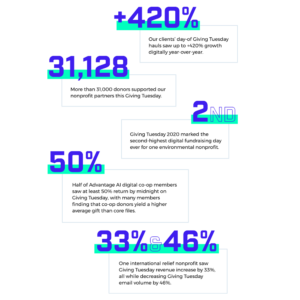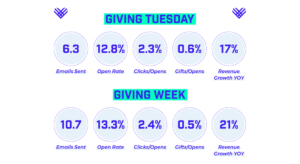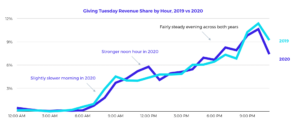Digital strategy
Final Report: Giving Tuesday 2020

You’re living the decade that is 2020. And in a year like this, we all need a dose of good news now and again. So here goes: Americans showed up generously on Giving Tuesday. In fact, on this single day, donors gave $2.47 billion to their favorite organizations – a 25% year-over-year increase. And that doesn’t even include the $500+ million raised domestically during May’s Giving Tuesday Now.
This year, our nonprofit partners saw their audiences reaffirm their support for lifesaving, world-changing missions like gun violence prevention, environmental protection, international relief, disability assistance, military aid, and more in profoundly inspiring ways.
It started with the organizations themselves – and the tireless work and selfless devotion to their causes – that resonated loudly with their audiences, even over the din of 2020’s chaos. Add to this a host of best practices, and some innovations we’ve picked up along the way, and you’ve got a recipe for a successful Giving Tuesday no matter what the outside world throws their way.
Here’s a look at our Giving Tuesday 2020 by the numbers – and keep scrolling for more insights on this year’s Giving Tuesday landscape:

We also crunched our clients’ email numbers to set some benchmarks for next year. In the table below we have averages across metrics for our aggregated nonprofit clients on Giving Tuesday itself, as well as Giving Week, which we’re defining as Black Friday through the following Thursday.


Giving Tuesday morning brought unparalleled anticipation – as well as frantic texts from others in the industry: “Results slow for you, or just here?” With WFH and virtual learning schedules disrupting daily routines, some organizations did in fact see declines in early morning returns, with peak performance happening later in the day on Giving Tuesday 2020 than in years past. One military aid organization raised about 29% of their Giving Tuesday haul before noon last year … but saw that same figure decline to 18% this year! But, don’t panic if things don’t go according to plan: That same org recouped that revenue later with some big spikes in revenue to close out the day.
While many nonprofit friends told us they experienced a similar trend, what does the data tell us? Well, that’s a bit murkier. We looked at a sample of clients for whom we had robust data, and we compared the share of their revenue earned across the day. At least for these clients, we saw a modest shift in revenue from the morning hours to the later hours, but only by about a percentage point: around 25% of revenue came in before noon in 2019 while just about 24% did in 2020.
Just glancing at the data for those clients below, you can see that 2020 was a bit more volatile (in more ways than one, right?). There were many more dramatic spikes in 2020 for a lot of our clients than in 2019 overall. Our lesson here is the same regardless: It’s OK if things start out slow – but always be prepared with additional content for later in the day in case you need it.


With the amount of competition out there, audiences don’t have time to read every message that comes through their inbox. And as we just noted, some of our clients and nonprofit friends saw softer results in the morning this year. Whatever the reason, we’re not ones to let a piece of good content go unseen. By trying the same email again – with a tweaked subject line – you’re able to extend the tail of a message and avoid needing to send a completely new email.
One of our clients even went as far back as the other Giving Tuesday this year. They recycled the top performer from May’s campaign, updated it for this Giving Tuesday, and saw it become the day’s third-best performer. Similarly, another organization resent a morning message later in the day and saw 7% higher revenue than the original message. Not bad for not having to create new content!
In a similar vein, for one client we noticed that our supporters acquired through Facebook weren’t engaging with our Giving Tuesday content at the same rate as our core file – so we dropped them from the rest of our Giving Tuesday series and resent some of our previous best performers. We daisy-chained some engagement asks (think quizzes and surveys) with fundraising upsells, packaged it all in some Giving Tuesday subject lines, and watched our numbers improve throughout the day.
For another nonprofit, we noticed some lower open rates early in the morning and were concerned about breaking through the noise. After a quick survey of our own inboxes showed us just how much Giving Tuesday content was out there, we made the decision to strip Giving Tuesday out of our envelope treatments completely. The result? Our highest open rate on the day didn’t mention Giving Tuesday at all.
Being able to capitalize on changing situations during big moments requires both internal and external teams capable of moving quickly, but we’ve seen time and again that it’s an incredibly successful way to bring in revenue down the stretch.

While it might be harder to stack more content into an already fully scheduled email calendar, in this increasingly competitive environment, many of our nonprofit organizations started looking for new and emerging channels to engage with their supporters on such a critical day. Taking a page from our political campaign friends, we helped a number of nonprofits jump into the SMS game this year – to great effect.
For a few of our clients, SMS was the key driver in their YoY revenue gains, and nearly all of our clients who had an existing SMS program before Giving Tuesday had their best messages in program history. So, if you’re not texting your supporters yet, you might want to think a bit more critically about investment. The way we see it, SMS is only going to be growing for nonprofits in the next few years.
Keep in mind that SMS isn’t without its own strategy and issues: With send delays across carriers on Giving Tuesday, many of our SMS clients had to pivot their messaging and quickly assess send-time optimization. Some organizations had to move their messages to the following day or even cancel the last message of the day. These pivots, however, did not make significant dents in results – one organization saw their post-Giving Tuesday message raise 50% more revenue than the day-of. And as we mentioned in previous posts, when pivoting messaging or creating content, be mindful of the way texts stack in users’ messaging apps. Since previous messages will display just above recent blasts, it’s important to diversify copy and strategically place fundraising asks in the program cadence.
Our lesson here is clear: If you feel like you’ve saturated some of your other channels like email and paid media and you’re not on SMS yet, give it a try! It can be an especially powerful tool for big moments like Giving Tuesday. But don’t treat SMS like an afterthought. Our clients that reap the most from it have a full SMS strategy. Not sure where to start? Ask us!

After $10 million raised for progressive candidates during the 2020 election cycle, Giving Tuesday was our first real test of our new digital data co-op’s power for nonprofit organizations – and it passed with flying colors.
We tested and launched Advantage AI with our largest nonprofit partners in advance of Giving Tuesday, quickly seeing results that aren’t possible with any other platform: Of those who ran fundraising email programs for Giving Tuesday, half saw a 50% return by midnight on Tuesday. One member saw a 70% return in just one day, and went on to raise back their entire investment within a week of Giving Tuesday. But ROAS wasn’t the only metric that Advantage AI names blew out of the water: We also saw, in a year when per-email revenue dipped across the industry, co-op names returning average gifts higher than overall donor files.
Given these incredible results, we’re especially excited about the effect Advantage AI could have on its members’ end-of-year fundraising power and into a full year of cultivation and engagement in 2021 and beyond. Want to learn more about joining the co-op? Email us at [email protected].
—
The logistics of Giving Tuesday are behind us, but these learnings are coming right along with us as we look ahead to critical end-of-year fundraising days. We’ll be keeping an eye out for how trends evolve as this tumultuous year comes to a close. If 2020 has taught us anything, it’s that we should expect the unexpected! You can expect to hear more from us as new data points emerge.
Stay tuned for an early January report with all the need-to-know trends and takeaways from Giving Tuesday and EOY.
Have an insight or result from Giving Tuesday you’d like to share – or just looking to chat about the tactics outlined here? Get in touch by sending us a note at [email protected].
Next insight